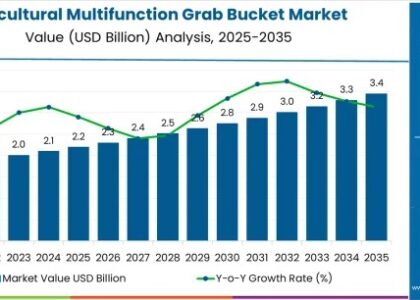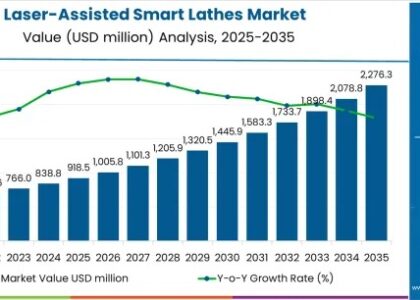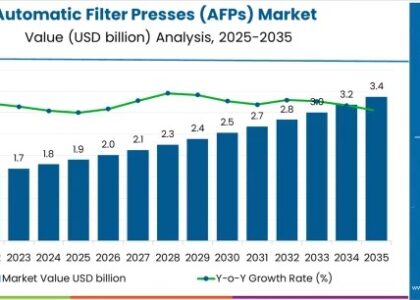The global programmatic display market is set to depict USD 85.4 billion in 2025. The industry is poised to register 24.6% CAGR from 2025 to 2035, reaching USD 1,883.4 billion by 2035.
In today’s fast-paced digital world, brands are no longer satisfied with broad messaging or static campaigns. They seek precision, speed, and personalization—and they want it all at scale. Enter the programmatic display market, a transformative force quietly reshaping how digital ads are bought, placed, and optimized in real time.
From banner ads to rich media and video, programmatic display is powering the next era of automated, data-driven advertising. Behind every seamless ad impression lies a complex web of algorithms, audience insights, and real-time bidding systems that allow marketers to reach the right user, with the right message, at the right moment.
Request Your Sample and Stay Ahead with Our Insightful Report!
https://www.futuremarketinsights.com/reports/sample/rep-gb-1321
More Than Just Automation: A Shift in Strategy
Programmatic display goes beyond automating ad placements—it introduces a strategic paradigm shift. Traditional ad buying relied on human negotiation and bulk impressions. In contrast, programmatic uses software and machine learning to buy ad space dynamically, based on user behavior, contextual signals, and performance metrics.
This real-time approach ensures brands get the most value from their ad spend while delivering more relevant and engaging experiences to users. With targeting that’s more granular and optimization that’s continuous, programmatic display is turning digital advertising into a performance-first discipline.
Fueling Growth with Data and AI
At the heart of programmatic display is data—lots of it. Whether sourced from first-party CRM systems, third-party behavioral data, or contextual analysis, this information feeds into demand-side platforms (DSPs) that determine when and where to place an ad.
AI and machine learning play a central role, analyzing patterns across demographics, browsing history, device usage, and even real-time actions. These systems learn and adapt, automatically adjusting bids, formats, and frequency to maximize campaign outcomes.

Formats That Flex and Engage
Programmatic display isn’t limited to static rectangles on web pages. The market has expanded to include interactive ads, native display, rich media, and programmatic video—all delivered with agility across devices and platforms.
Dynamic creative optimization (DCO) allows content to change on the fly, tailoring messaging, visuals, and calls-to-action based on user attributes. Whether it’s a product recommendation, weather-based promotion, or geo-targeted offer, the result is advertising that feels timely and personalized.
Omnichannel Delivery in a Fragmented Landscape
Consumers today move fluidly between screens, apps, and platforms—and programmatic display follows them seamlessly. Ads are now delivered across websites, mobile apps, connected TVs (CTV), and digital out-of-home (DOOH) spaces, all through a single unified platform.
This omnichannel reach allows marketers to maintain consistency in messaging and maximize exposure across multiple touchpoints. At the same time, advanced attribution models provide visibility into which channels are driving engagement, conversions, and return on investment.
Transparency, Privacy, and the Push for Trust
Despite its advantages, the programmatic display ecosystem faces ongoing scrutiny over issues of transparency, ad fraud, and user privacy. Marketers demand clear insight into where their ads are running, who is viewing them, and how budgets are being allocated.
Regulatory changes and the gradual decline of third-party cookies have also sparked a shift toward privacy-focused solutions. Contextual targeting, data clean rooms, and first-party data strategies are emerging to maintain relevance while respecting consumer consent.
Thorough Market Evaluation: Full Report
https://www.futuremarketinsights.com/reports/programmatic-display-advertising-market
Challenges and the Road Ahead
Programmatic display’s complexity is both its strength and its challenge. Integrating disparate data sources, managing brand safety, and maintaining performance across fragmented environments requires expertise and continuous refinement.
Moreover, smaller advertisers may face a steep learning curve or resource constraints. To address this, platform providers are offering more intuitive interfaces, AI-assisted campaign setups, and managed service options to democratize access to programmatic capabilities.
Smart, Scalable, and Always On
In an age where attention is fleeting and personalization is expected, programmatic display offers a powerful solution for advertisers looking to stay ahead. It automates the mundane, amplifies the strategic, and empowers brands to speak directly to their audiences—no matter the channel or context.
Quietly running behind every click, scroll, and view, programmatic display is proving that the future of advertising is not only automated—but also intelligent, adaptive, and deeply human in its execution. As marketing continues to evolve, this technology-driven approach is ensuring that brand stories reach the right eyes, at the perfect time.





